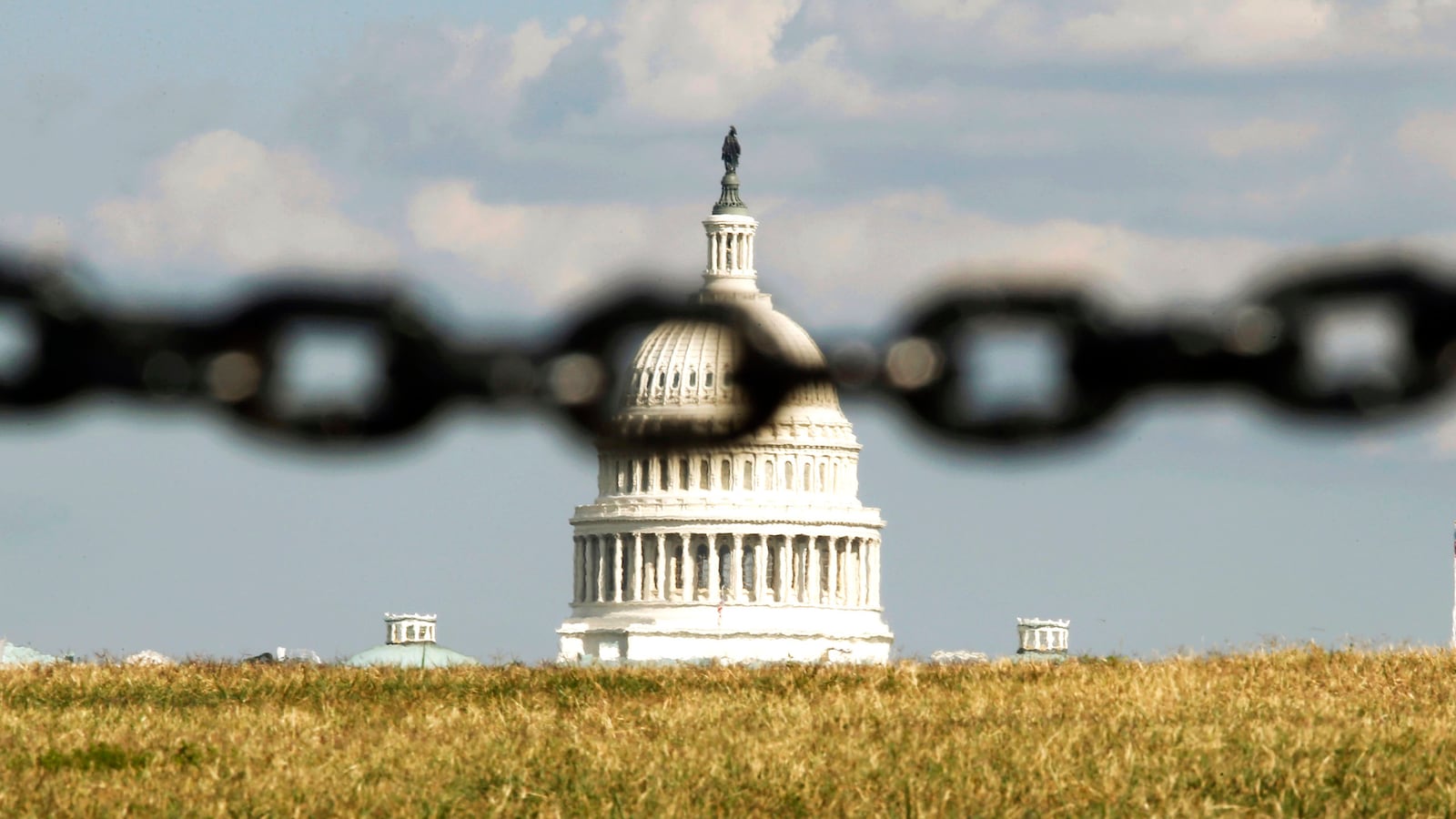As the federal government gets dangerously close to the first shutdown of the Trump era, the president has remained relatively calm behind the scenes and, according to those around him, seemingly ambivalent in a time of political disarray.
Inside the White House, his level of preparation for an increasingly possible government shutdown seems to be focused mainly on shoveling the blame onto Democrats on Capitol Hill.
“A government shutdown will be devastating to our military... something the Dems care very little about!” Trump tweeted on Thursday morning. He then went on to throw congressional negotiations into chaos—in tweets seemingly prompted by his cable news habit—by siding with Democrats seeking a long-term fix to an imperiled children’s health insurance program (CHIP), not the stopgap measure congressional Republicans are pushing.
The dichotomy on display this week was emblematic of the scattershot approach Trump has brought to legislating all year. But the consequences of this particular political battle are far higher than the previous ones, with massive ramifications for federal programs, including U.S. military payrolls.
Even as he throws the occasional wrench in the works, the president has been working the phones with lawmakers in their efforts to avert a shutdown by Friday night. On Thursday, Trump called into the House Freedom Caucus meeting to negotiate directly with the hardline conservative group.
Within hours the Freedom Caucus acquiesced to House leadership’s preferred spending package in exchange for future promises. The bill—which would fund the government for four weeks, delay several Obamacare-related taxes, and authorize six years of funding for the CHIP program—passed the House later in the evening by a vote of 230-197.
Notwithstanding those results, close friends and aides to Trump have noticed a president vacillating, sometimes in the span of a few hours, between indifference and partisan feuding. Over the past two weeks, Trump has repeatedly fumed at Democrats who would, he insists, enjoy a government shutdown because it would “reverse” or “do damage” to his administration’s post-tax reform momentum, according to two sources who’ve spoken with the president recently. Other days, and sometimes in the same breath, the president would speculate (as he had during a past shutdown scare) that a shutdown could be politically advantageous to him.
This reflects an attitude toward the prospect of the government grinding to a halt that, for this president, actually goes back years. “[Republican] leadership should not be afraid of a government shutdown,” he tweeted in September 2013. “They should be afraid of not defunding ObamaCare.”
White House officials and outside advisers have reminded him that, if recent historical trends are to be believed, Republicans will shoulder the lion’s share of public blame—especially at a time when the GOP controls the levers of power in Washington. “He just doesn’t see it that way,” one official noted, referring to Trump’s refusal to acknowledge that this could be a political blow to his own party.
Another person who has spoken to the president this week told The Daily Beast that Trump has joked that it would be a “shame” if a government shutdown were to occur on, or overshadow, the first anniversary of his inauguration as president.
Outside of the White House, agencies that would take the lead in dealing with the significant logistical challenges posed by a shutdown are suffering from significant staffing challenges at the highest levels.
The White House Office of Management and Budget coordinates administration-wide shutdown procedures, and each federal agency must submit its shutdown plans to OMB in the event of a lapse in federal appropriations. OMB is also tasked with monitoring the status of congressional appropriations during a shutdown, briefing agencies on their responsibilities, and even drafting memos to send to furloughed agency employees.
It’s a wide array of duties. But the office is currently operating without a full-time chief executive. OMB Director Mick Mulvaney is splitting his time between White House budget duties and the Consumer Financial Protection Bureau, which he has led on an interim basis since November. OMB did not respond to a request for comment on Mulvaney’s dual roles and whether it might affect its ability to handle shutdown logistics.
At the same time, another federal agency crucial to managing a government shutdown is also operating without a full roster of senior leadership. The Office of Personnel Management, which oversees a federal workforce that would be hit with large furloughs, currently has no permanent director.
Trump initially nominated former George W. Bush OPM official George Nesterczuk to lead the agency, but he withdrew after heated opposition from major labor unions threatened to turn his nomination into “a distraction for the administration,” as he wrote in a letter to the president.
Trump subsequently nominated human resources professional Jeff Tien Han Pon to the director post. But neither Pon nor Mike Rigas, a former senior official at the Massachusetts Department of Veterans’ Services tapped to be OPM’s second-in-command, have even received a Senate committee vote in the months since their nominations.
Sen. Ron Johnson (R-WI), chairman of the Senate Homeland Security and Governmental Affairs Committee, has held up both of those nominations, citing OPM’s noncompliance with a committee subpoena for records related to an OPM regulation that exempted members of Congress from provisions of Obamacare.
“The chairman is not satisfied with the OPM’s production to the committee and he expects OPM to fully comply with the subpoena. Discussions to facilitate full compliance with the subpoena remain ongoing,” a committee spokesperson told The Daily Beast when asked about the status of the nominations on Thursday. The spokesperson did not respond to follow-up questions about the effect that that leadership vacuum might have on shutdown operations.
Veterans of past government shutdown standoffs looked on with a mix of horror and bemusement.
Obama administration officials who spoke to The Daily Beast said they were shocked at the apparent lack of seriousness with which lawmakers, and the Trump White House, appeared to be approaching the potential funding lapse. When they went through a shutdown in 2013—and when they prepped for one in 2011—the contingency planning took weeks. Each federal agency produced comprehensive plans for who would be identified as critical staff, who would be subjected to furlough, how reserve funds and operating fees would affect operations, and so on. These contingency plans weren’t just blueprints for life-in-the-wake of a shut down. They were lifelines, since offices had to operate with far fewer human and monetary resources.
As of late Thursday afternoon, however, numerous federal agencies appeared to have not submitted updated plans to the Office of Management and Budget. Of the nearly 130 agencies and offices that submit contingency plans, 66 of them had not publicly updated their proposals since 2015.
“I just cannot imagine working at an agency without an updated contingency plan, without the days and weeks we spent working through the worst case scenarios of funding and staffing,” said Melanie Newman, who worked at the Department of House and Urban Development and OMB under Obama. “It can only result in chaos.”
Even without up-to-date contingency plans, however, a shutdown would have major effects across government. Parks would close. Certain services would be curtailed or ended. Funding for research gets suspended. And then there is the human toll. According to the most recent plans, 14,536 of the 18,530 employees at the National Institutes of Health would be furloughed while 8,440 of the 12,974 staffers at the Centers for Disease Control and Prevention would experience the same fate. And it happens to be the height of flu season.
It’s not just the agencies, though, who will be impacted. The city of Washington, D.C., would see government functions upended, including, potentially, parking enforcement and trash pickup. A spokesperson for the D.C. mayor’s office did not immediately address if garbage would be collected if light of a shutdown.
Establishments that depend on the federal workforce, like restaurants around Cabinet offices, will see dramatic and potentially crippling loss of business.
As for Trump, he would see an impact too. The Executive Office of the President would be forced to furlough workers in light of a shutdown. The operational impacts of that, as one Obama White House official explained, would be felt in the form of innumerable nuisances.
“We didn’t have any press wranglers. We didn’t have anyone to do Jay Carney’s book when he briefed. We didn’t have anyone to run the conference calls. We didn’t have anyone who knew how to do the press list,” the official said. “I don’t think people understand how hard it is. Though, I suppose, [the Trump White House] may not be able to tell the difference.”
—with additional reporting by Gideon Resnick








